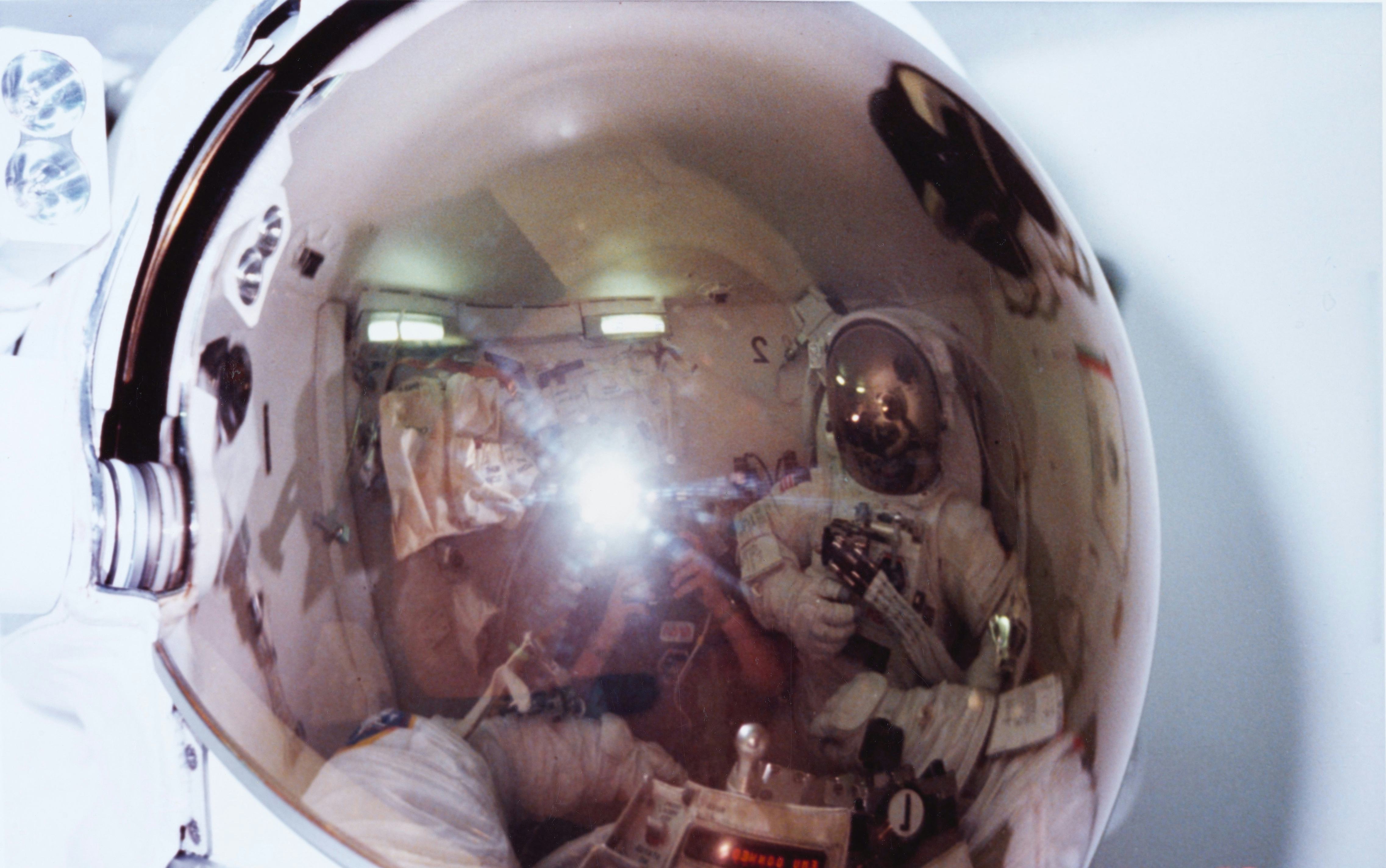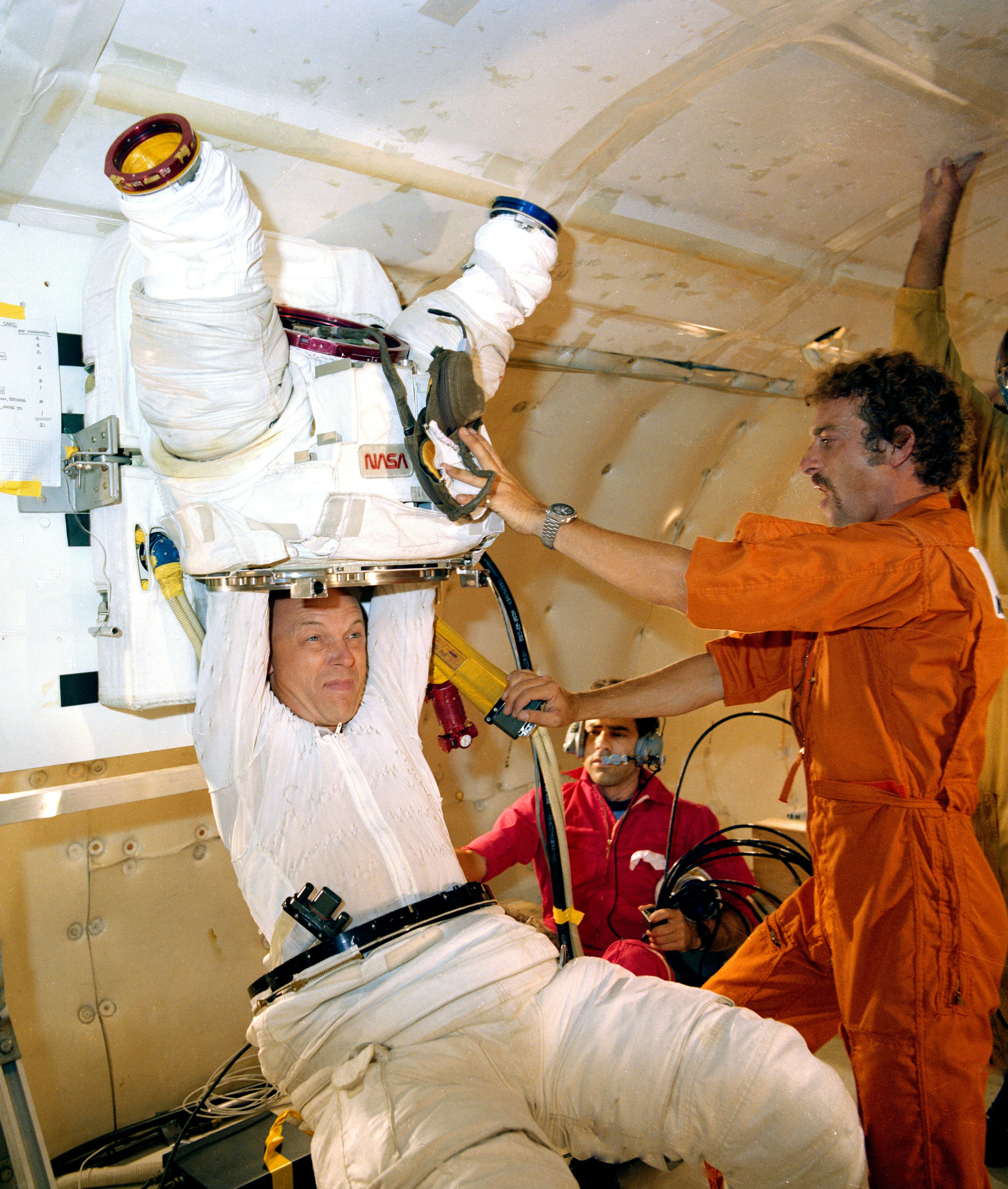
It’s difficult to imagine a film or series set in space without a scene containing an astronaut in dire straits in the vast of reaches of space. Forty years ago this week, the sixth Space Shuttle mission, STS-6, and the first flight of the Space Shuttle Challenger, not only launched the first Tracking and Data Relay Satellite, TDRS-1, but it served another role of monumental importance in the evolution of human space travel — as a test for shuttle spacewalks, formally known as extravehicular activities (EVAs).
As it turns out, this was the first spacewalk of the Space Shuttle missions, but came years after the first EVA in history. The first spacewalk, which was more of a float, was performed eighteen years prior by Alexei Leonov on the Voshkod 2 in March 1965, who spent 12 minutes outside the spacecraft.
Leonov, whose only navigational control outside of the ship was via his tether, encountered a number of concerning problems, including a spacesuit that ballooned so much without confining pressure in the vacuum of space, that made it too difficult for him to reenter. He had to decompress the suit, a problem which gave him the bends — a potentially life-threatening condition. There were undoubtedly improvements to be made in the spacesuit’s engineering.
Cathleen Lewis, curator at Smithsonian’s National Air and Space Museum, explains that EVA spacesuits are actually a world of engineering unto themselves, and are actually worlds away from the spacesuits that normally come to mind in various imaginings of astronauts inside a spaceship.
“An EVA suit is in fact a human shaped spacecraft,” Lewis tells Inverse. “The spacesuits that we're probably more familiar with are the spacesuits that astronauts wear for launch. And those are called launch and entry suits. Pilots affectionately referred to them as get-me-down suits.”
“They are suits designed to be backups to the life support systems, onboard a spacecraft,” she adds. “That just in case of depressurization, or in case they have to parachute from a very high altitude, that they're really only operational and functional for a few minutes in space and just long enough to get an astronaut safely through the atmosphere.”
Lewis explained in simple terms why EVA suits are another ballgame.
“An EVA suit is in fact a human-shaped spacecraft,” she said. “It provides everything from oxygen supply pressure, it allows for communications between the spacecraft and between the astronaut and ground control on Earth.”
She adds that it also regulates body temperature, and protects against radiation and debris zipping by at 17,500 miles per hour. Lewis says that presently, NASA has capabilities to detect debris larger than a tennis ball, but one of these suits needs to safeguard anything smaller than a tennis ball, traveling faster than a bullet.

NASA and the EVA
Just months after Leonov’s near-fatal EVA, Ed White, made his debut spacewalk for the Americans. He made it an additional eight minutes on top of Leonov’s twelve, for a total of 20 minutes in space. This was part of Project Gemini’s second mission, Gemini’s entire goal being to prepare for the Apollo missions that came in the following years.
In January 1969, Soyuz 4 and Soyuz 5 docked together and two Russian astronauts, Aleksei Yeliseyev and Yevgeny Khurnov, performed a transfer between the two spaceships — it was the third EVA.
The Apollo Missions EVAs brought their own brand of challenges. Since they were based on the lunar surface, they would actually require that the astronauts walk. The first moonwalk on July 20, 1969 was 2 hours and 31 minutes. Aldrin and Armstrong had spacesuits with built-in life support systems. According to Lewis, each spacesuit was uniquely built for each astronaut, and each had three suits: a training suit, a flight suit and a backup suit.
It wouldn’t be until 1973 until the next EVA when the three astronauts, Charles "Pete" Conrad, Joseph Kerwin, and Paul J. Weitz performed the first repairs in space on Skylab space station over three separate days — on May 26, June 7, and June 19. There were 10 EVAs to complete the repairs.
Whereas the Apollo mission EVAs required that the spacesuits allow for some flexibility for movement in the lower body, these EVAs required that the spacesuits be designed with an emphasis on manual dexterity. It also demonstrated how much longer repairs take in space as on the ground — around 2.5 times as long, much of it due to space sickness.
But the Skylab EVAs would be NASA’s last for a decade, until STS-6 launched from April 4, 1983 from Kennedy Space Center.
“The benefits of the shuttle was that you could launch humans and a spacecraft at the same time,” Lewis says. “Then the humans could sort of lifted up or guided [the satellite] into to orbit, get it out of the payload bay, and then it would then be able to take off freely from low Earth orbit.” It was up to the astronauts to guide the satellite out of the payload bay — in the case of TDRS-1, physically lifting it out rather than using the remote manipulator arm.

How the Space Shuttle Changed the EVA
Astronauts Donald Peterson and F. Story Musgraves successfully completed their EVA on April 7, 1983.
Just recently, the film Gravity features George Clooney zipping around space with a maneuverable jet pack. Though seemingly precarious, this means of extravehicular activity (EVA) is not as far-fetched as it may seem. Only a year after STS-6, during Space Shuttle mission STS-41-B, astronauts actually used manned maneuvering units (MMUs) – like Clooney’s – to perform EVAs, thanks to a successful predecessor. It didn’t last long, though. NASA phased it out after a year.
"We're once again, talking about an iterative process that they're following. And a very conservative process," Lewis explained. "You know, we were talking about human life, so the decisions that they make on the use of equipment is inherently very conservative. You don't want to take those great leaps of faith when you're talking about human lives."
It turns out that unlike the Apollo spacesuits, which cost about a quarter-of-a-million dollars each and were made for each astronaut individually, most current spacesuits still use shuttle suits, and cost around $3 million each, Lewis says.
When NASA began making these suits, they were pretty forward-thinking in terms of the growth of the astronaut fleet. Because astronauts may use the same or similar suits, they needed to accommodate different body types, recognizing the diversity of the astronaut corps, including the first American women to go to space.
“One of the mandates was that this space suit would be reusable, that NASA wasn't going to go for the individually fitted spacesuits, some very expensive enterprise, it would have to be modular, that the astronaut would be able to fit the suit for themselves,” Lewis says. “So the suit was under contract to be designed to fit everything from a woman who is a fifth percentile in size, to a man who's 95th percentile.”
The vast majority of humans can fit in some of these spacesuits originating from the STS-6 missions; so can their hands. Lewis said there are over 200 CAD models that fit the majority of human hands, for all aspiring astronauts.







